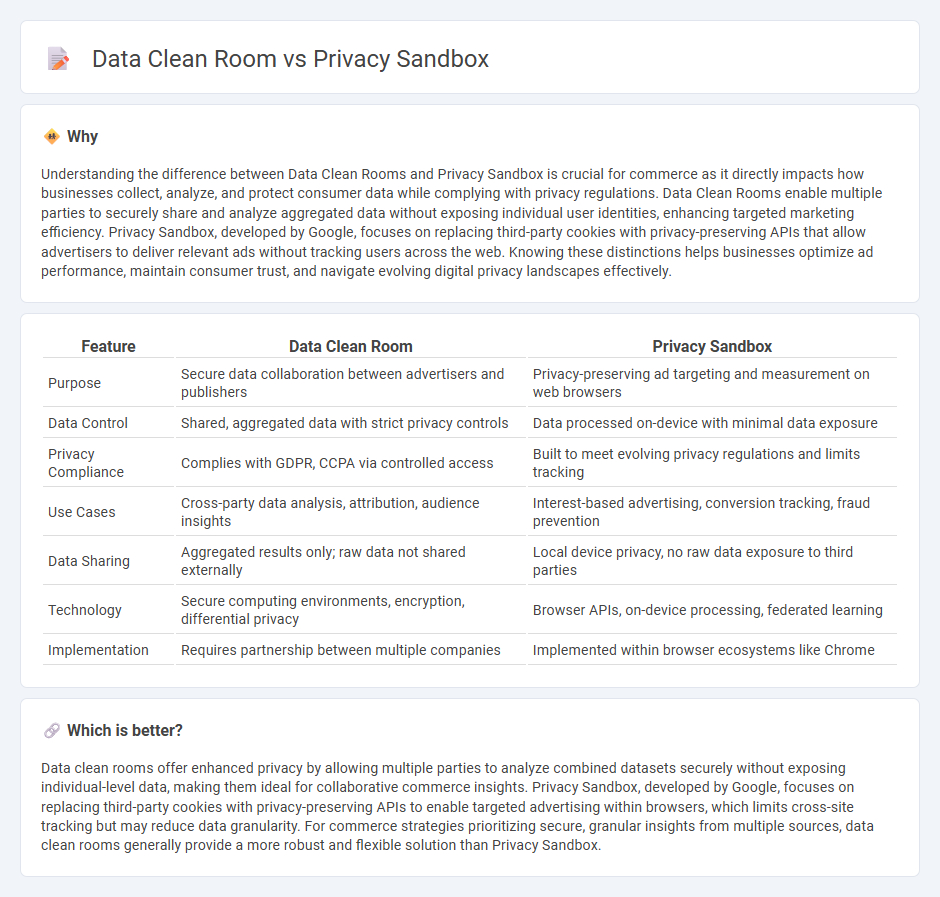
Data clean rooms enable secure data collaboration between companies without sharing personally identifiable information, enhancing user privacy while allowing targeted marketing. Privacy Sandbox, developed by Google, introduces privacy-preserving APIs that limit cross-site tracking and curb third-party cookie usage in digital advertising. Explore how these technologies reshape commerce and digital advertising strategies by learning more.
Why it is important
Understanding the difference between Data Clean Rooms and Privacy Sandbox is crucial for commerce as it directly impacts how businesses collect, analyze, and protect consumer data while complying with privacy regulations. Data Clean Rooms enable multiple parties to securely share and analyze aggregated data without exposing individual user identities, enhancing targeted marketing efficiency. Privacy Sandbox, developed by Google, focuses on replacing third-party cookies with privacy-preserving APIs that allow advertisers to deliver relevant ads without tracking users across the web. Knowing these distinctions helps businesses optimize ad performance, maintain consumer trust, and navigate evolving digital privacy landscapes effectively.
Comparison Table
| Feature | Data Clean Room | Privacy Sandbox |
|---|---|---|
| Purpose | Secure data collaboration between advertisers and publishers | Privacy-preserving ad targeting and measurement on web browsers |
| Data Control | Shared, aggregated data with strict privacy controls | Data processed on-device with minimal data exposure |
| Privacy Compliance | Complies with GDPR, CCPA via controlled access | Built to meet evolving privacy regulations and limits tracking |
| Use Cases | Cross-party data analysis, attribution, audience insights | Interest-based advertising, conversion tracking, fraud prevention |
| Data Sharing | Aggregated results only; raw data not shared externally | Local device privacy, no raw data exposure to third parties |
| Technology | Secure computing environments, encryption, differential privacy | Browser APIs, on-device processing, federated learning |
| Implementation | Requires partnership between multiple companies | Implemented within browser ecosystems like Chrome |
Which is better?
Data clean rooms offer enhanced privacy by allowing multiple parties to analyze combined datasets securely without exposing individual-level data, making them ideal for collaborative commerce insights. Privacy Sandbox, developed by Google, focuses on replacing third-party cookies with privacy-preserving APIs to enable targeted advertising within browsers, which limits cross-site tracking but may reduce data granularity. For commerce strategies prioritizing secure, granular insights from multiple sources, data clean rooms generally provide a more robust and flexible solution than Privacy Sandbox.
Connection
Data clean rooms and Privacy Sandbox are interconnected solutions designed to enhance user privacy while enabling effective commerce analytics. Data clean rooms provide secure environments where multiple parties can share and analyze aggregated data without exposing personally identifiable information, aligning with Privacy Sandbox's goal to limit third-party tracking and fingerprinting. Together, they facilitate privacy-compliant ad targeting and measurement, critical for maintaining trust and performance in digital commerce ecosystems.
Key Terms
Third-party Cookies
Privacy Sandbox aims to phase out third-party cookies by introducing new web standards that enhance user privacy while enabling targeted advertising through aggregated data signals. Data clean rooms provide secure, privacy-compliant environments for advertisers and publishers to analyze user data collaboratively without exposing individual information, serving as an alternative to traditional cookie-based tracking. Explore the nuances of these technologies to understand their impact on the future of online advertising.
Federated Learning
Privacy Sandbox enhances user privacy by limiting cross-site tracking and enabling interest-based ad targeting without exposing personal data. Data clean rooms support Federated Learning by aggregating encrypted user data from multiple sources to train models securely, preserving data confidentiality. Explore how integrating Privacy Sandbox with data clean rooms can advance Federated Learning frameworks for privacy-centric advertising and analytics.
Encrypted Data Collaboration
Encrypted Data Collaboration within Privacy Sandbox enhances user privacy by enabling secure data sharing without exposing raw user identifiers, while data clean rooms provide controlled environments for aggregated, anonymized insights from multiple data sources. Privacy Sandbox leverages cryptographic techniques to limit cross-site tracking and ensure compliance with privacy regulations, whereas data clean rooms focus on allowing advertisers and publishers to collectively analyze campaign performance without leaking personal data. Explore how these privacy-first technologies are transforming digital advertising and data analytics.
Source and External Links
What is the Privacy Sandbox? - Google - Privacy Sandbox is an initiative by Google to create technologies that protect online privacy by reducing cross-site and cross-app tracking while providing alternatives to third-party cookies, with browsers acting on users' behalf locally to safeguard data as they browse the web.
Google's Privacy Sandbox: What you need to know - MarTech - Google's Privacy Sandbox encompasses a suite of proposals to protect user privacy, originally aiming to replace third-party cookies with new methods like Topics, and includes developments on Android to preserve app advertising while limiting tracking.
What is Google's Privacy Sandbox on Android - Adjust - On Android, Privacy Sandbox is a privacy-first solution designed to reduce reliance on device identifiers like the Google Advertising ID, enabling personalized advertising and measurement while limiting cross-app data sharing to protect user privacy.
 dowidth.com
dowidth.com